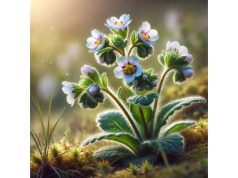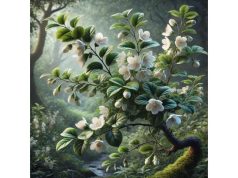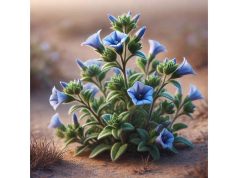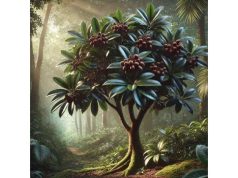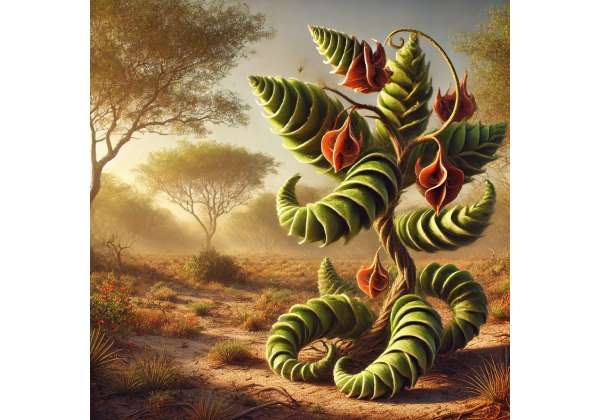
East Indian Screw Tree is an intriguing herb native to the tropical and subtropical regions of East India. Characterized by its uniquely twisted, screw-like branches and lush, vibrant foliage, this herb has been a cornerstone of traditional healing systems for centuries. Its rich array of bioactive compounds, including potent antioxidants and anti-inflammatory agents, makes it a versatile natural remedy for a wide range of ailments—from digestive disorders to immune support. In both culinary and medicinal traditions, East Indian Screw Tree is revered not only for its distinctive aroma and flavor but also for its ability to promote overall health and well-being. Today, modern research is beginning to validate its traditional uses, shining new light on its potential to support metabolic health, soothe inflammation, and boost energy.
- Supports healthy digestion and alleviates gastrointestinal discomfort
- Provides powerful antioxidant and anti-inflammatory effects
- Enhances immune function and aids in recovery from infections
- Promotes cardiovascular health and metabolic balance
- Offers natural relief for respiratory ailments
- Contributes to overall energy, vitality, and mental clarity
- Adds a unique, earthy flavor to culinary dishes
Table of Contents
- East Indian Screw Tree Botanical Profile and Key Characteristics
- East Indian Screw Tree Historical Significance and Cultural Impact
- East Indian Screw Tree Phytochemical Composition and Active Compounds
- East Indian Screw Tree Therapeutic Benefits and Health Properties
- East Indian Screw Tree Uses, Applications, and Safety Considerations
- East Indian Screw Tree Scientific Research and Recent Studies
- East Indian Screw Tree Frequently Asked Questions (FAQ)
East Indian Screw Tree Botanical Profile and Key Characteristics
The East Indian Screw Tree (Helicteres isora) is a robust, deciduous tree that thrives in arid and semi-arid climates. Recognizable by its spirally twisted fruits and rugged, fissured bark, this tree is well adapted to harsh environmental conditions. Its botanical features are as unique as its name suggests.
Morphology and Growth Habits
East Indian Screw Tree typically reaches heights of 10–15 meters. The tree’s bark is dark and deeply grooved, providing a natural defense against pests and harsh climatic conditions. Its leaves are simple, lanceolate, and arranged alternately along the branches, exhibiting a glossy texture that contributes to the tree’s overall resilience. The most striking feature, however, is the spiral or “screw-like” fruit, which gives the tree its common name. These fruits are elongated capsules that twist in a spiral manner as they mature, a characteristic that not only aids in seed dispersal but also distinguishes the species from other tropical trees.
Habitat and Ecological Adaptations
Native to the Indian subcontinent and extending to parts of Southeast Asia, the East Indian Screw Tree thrives in regions with well-drained, sandy loam soils. It is highly drought-tolerant, thanks to its extensive root system, which allows it to absorb and store water during the rainy season. This resilience enables the tree to survive in arid conditions where many other plants would perish. In its native habitat, the East Indian Screw Tree plays a critical role in maintaining ecological balance by preventing soil erosion and providing habitat for a variety of bird and insect species that contribute to pollination and natural pest control.
Cultivation Practices
Traditional farming practices in India have long incorporated the East Indian Screw Tree as a multipurpose crop. It is often intercropped with other medicinal and culinary herbs, benefiting from mutual soil enrichment and natural pest resistance. Modern cultivation techniques emphasize organic farming methods to maintain the purity of the tree’s bioactive compounds. Sustainable harvesting practices ensure that the tree’s fruits and bark can be collected without compromising its regenerative capacity, making it a model for sustainable agroforestry in arid regions.
Genetic Diversity and Varietal Differences
Over centuries, local farmers and herbal practitioners have selected strains of the East Indian Screw Tree that exhibit superior growth characteristics, higher yields of bioactive compounds, and enhanced resistance to local pests and diseases. This selective breeding has resulted in a range of cultivars adapted to diverse microclimates and soil conditions. Researchers are actively studying this genetic diversity to develop improved varieties that can be cultivated on a larger scale while preserving the tree’s traditional medicinal properties.
The East Indian Screw Tree’s botanical profile—marked by its distinctive morphology, ecological adaptability, and sustainable cultivation practices—underscores its value as both a natural resource and a medicinal herb. Its ability to flourish in challenging environments while providing a wealth of therapeutic benefits makes it an indispensable component of traditional health systems and modern herbal research.
East Indian Screw Tree Historical Significance and Cultural Impact
The East Indian Screw Tree has a rich history steeped in traditional medicine and cultural heritage. For generations, this tree has been an integral part of indigenous health practices and local folklore, with its uses documented in ancient Ayurvedic texts and regional medicinal compendiums.
Traditional Medicinal Uses
In ancient Ayurveda, the East Indian Screw Tree was revered for its potent medicinal properties. Traditional healers used various parts of the tree—especially the bark, leaves, and fruits—to prepare decoctions, powders, and poultices. These preparations were employed to treat a range of ailments, including digestive disorders, fever, inflammation, and respiratory issues. The anti-inflammatory and antimicrobial properties of the tree made it particularly effective in managing skin conditions and wounds. Its use as a natural remedy for diabetes and other metabolic disorders is also well documented in historical texts, where it was prized for its ability to regulate blood sugar levels and improve overall metabolic health.
Cultural and Symbolic Importance
Beyond its medicinal applications, the East Indian Screw Tree holds significant cultural value. In many rural communities, the tree is considered a symbol of resilience and longevity, reflecting its ability to thrive in harsh environments. Local folklore often attributes mystical properties to the tree, with stories passed down through generations about its role in protecting villages from evil spirits and natural calamities. Rituals and festivals in some regions incorporate the tree as a sacred element, underscoring its status as both a healer and a guardian of tradition.
Oral Traditions and Knowledge Transmission
Much of the knowledge surrounding the East Indian Screw Tree has been preserved through oral traditions. Elders and traditional healers have long shared their expertise on the cultivation, harvesting, and medicinal uses of the tree with younger generations. This indigenous knowledge, rich in practical wisdom and cultural significance, is now being documented by ethnobotanists and researchers. Efforts to preserve and integrate this traditional knowledge with modern scientific practices are crucial in maintaining the tree’s legacy for future generations.
Socioeconomic Impact
Historically, the cultivation and use of the East Indian Screw Tree have had a profound impact on local economies. The tree not only provides medicinal and nutritional benefits but also supports livelihoods through sustainable agroforestry practices. Small-scale farmers have benefited from the trade of its fruits and bark, which are used both locally and in export markets for herbal formulations and natural remedies. In recent years, renewed interest in traditional herbs has spurred initiatives aimed at promoting the East Indian Screw Tree as a cash crop, thereby contributing to rural development and economic empowerment.
The historical significance of the East Indian Screw Tree is a testament to its enduring value in traditional medicine and cultural life. Its multifaceted role as a natural remedy, a symbol of resilience, and an economic resource continues to influence modern health practices and community development initiatives.
East Indian Screw Tree Phytochemical Composition and Active Compounds
The therapeutic efficacy of the East Indian Screw Tree is underpinned by its rich and diverse phytochemical profile. Modern analytical techniques have enabled researchers to identify a wide array of bioactive compounds in this tree, providing scientific validation for many of its traditional uses.
Key Bioactive Constituents
One of the most significant components of the East Indian Screw Tree is its abundance of alkaloids. These naturally occurring compounds are known for their broad pharmacological activities, including anti-inflammatory, antimicrobial, and analgesic effects. In addition to alkaloids, the tree contains various flavonoids and polyphenols—powerful antioxidants that help neutralize free radicals and reduce oxidative stress. These compounds are crucial in protecting cells from damage and play a vital role in the tree’s ability to support overall health.
Essential Oils and Terpenoids
The essential oils extracted from the East Indian Screw Tree are another major contributor to its medicinal properties. Rich in terpenoids, these volatile compounds not only impart a distinctive aroma but also possess antimicrobial and anti-inflammatory activities. Terpenoids such as limonene and pinene have been identified in the extracts, and these molecules are known to enhance immune function and provide relief from inflammatory conditions.
Saponins and Glycosides
In addition to alkaloids and flavonoids, the East Indian Screw Tree contains saponins and glycosides. These compounds are known for their immune-modulating and cholesterol-lowering effects. Saponins, in particular, contribute to the tree’s ability to reduce inflammation and support metabolic health, making them an important component in its traditional use for managing conditions like diabetes and hyperlipidemia.
Synergistic Interactions
The therapeutic power of the East Indian Screw Tree is not solely due to individual compounds but rather to the synergistic interaction among its various bioactive constituents. This complex interplay enhances the overall efficacy of the tree’s extracts, making them more effective than isolated compounds. The combined action of alkaloids, flavonoids, terpenoids, and saponins results in a potent formula that supports multiple aspects of health—from reducing oxidative stress and inflammation to boosting immunity and improving metabolic function.
Extraction and Standardization
Modern extraction techniques, such as solvent extraction, steam distillation, and cold pressing, have been optimized to isolate and preserve the delicate bioactive compounds found in the East Indian Screw Tree. Standardization of these extracts is essential to ensure consistency in potency and quality, particularly when the extracts are used in clinical studies or commercial formulations. Ongoing research aims to refine these processes further, improving the yield and purity of the active compounds for use in both traditional remedies and modern nutraceuticals.
In summary, the comprehensive phytochemical composition of the East Indian Screw Tree provides a robust scientific basis for its wide-ranging therapeutic applications. The tree’s rich blend of alkaloids, flavonoids, essential oils, and saponins underlies its ability to support health and combat a variety of ailments, validating centuries of traditional use with modern scientific evidence.
East Indian Screw Tree Therapeutic Benefits and Health Properties
The East Indian Screw Tree has been traditionally used as a natural remedy for a multitude of health conditions. Its impressive range of therapeutic benefits is supported by both historical practices and emerging scientific research, making it a valuable component in holistic health regimens.
Digestive Health and Gastrointestinal Support
One of the most well-known uses of the East Indian Screw Tree is its ability to promote digestive health. Traditional healers have long employed its bark and fruit extracts to treat various gastrointestinal disorders such as indigestion, bloating, and diarrhea. The anti-inflammatory and antimicrobial properties of its bioactive compounds help soothe the gastrointestinal lining, promote the healing of ulcers, and restore a balanced gut environment. Additionally, the tree’s natural fiber content contributes to improved digestion and regular bowel movements.
Anti-Inflammatory and Antioxidant Effects
The potent anti-inflammatory and antioxidant properties of the East Indian Screw Tree are central to its therapeutic value. The presence of flavonoids, polyphenols, and alkaloids work synergistically to reduce inflammation throughout the body, making it beneficial in managing chronic inflammatory conditions such as arthritis and inflammatory bowel disease. These compounds also scavenge free radicals, thereby reducing oxidative stress—a key contributor to aging and chronic diseases. Regular use of the tree’s extracts can therefore play a role in maintaining overall cellular health and longevity.
Blood Sugar Regulation and Metabolic Support
Emerging evidence suggests that the East Indian Screw Tree may help regulate blood sugar levels, making it a useful adjunct in the management of diabetes. Traditional medicine practitioners have utilized its extracts to improve insulin sensitivity and reduce hyperglycemia. The bioactive compounds in the tree appear to influence metabolic pathways, contributing to better lipid profiles and improved energy metabolism. These properties not only support diabetic patients but also benefit individuals seeking to maintain metabolic balance and prevent lifestyle-related diseases.
Immune System Enhancement
The immunomodulatory effects of the East Indian Screw Tree are another significant benefit. Its diverse array of antioxidants and anti-inflammatory compounds supports the immune system by reducing the impact of environmental stressors and pathogens. This enhanced immune function can lead to a reduced incidence of infections and a more robust overall defense system, which is particularly valuable during periods of high stress or seasonal changes.
Skin Health and Wound Healing
Topical applications of East Indian Screw Tree extracts have been traditionally used to promote skin health. The anti-inflammatory and antimicrobial properties of the herb help in the healing of minor cuts, abrasions, and skin irritations. Its ability to reduce inflammation and support cellular regeneration makes it a popular ingredient in natural skincare formulations, contributing to clearer, healthier skin.
Holistic Well-Being
Overall, the diverse therapeutic benefits of the East Indian Screw Tree contribute to a holistic approach to health. Whether used internally to support metabolic and immune functions or applied externally for skin healing, the tree’s multifaceted properties make it an integral part of both traditional and modern natural medicine. Its versatility and broad spectrum of actions underscore its importance as a natural remedy that supports overall well-being.
East Indian Screw Tree Uses, Applications, and Safety Considerations
The East Indian Screw Tree is valued for its diverse applications in both culinary and medicinal contexts. Its versatility allows it to be used in various forms, each tailored to specific health needs. However, as with all herbal remedies, adherence to proper usage and safety guidelines is essential to maximize benefits and minimize risks.
Culinary and Nutritional Applications
Traditionally, parts of the East Indian Screw Tree have been incorporated into local diets. In some regions, the fruits and young leaves are used to prepare herbal teas and decoctions that support digestive health and general vitality. The unique flavor profile of the tree, often described as mildly bitter with earthy undertones, lends itself well to traditional recipes where it is used to enhance the nutritional quality of meals without overpowering the dish.
Herbal Remedies and Supplement Forms
Herbal practitioners have developed a variety of preparations using the East Indian Screw Tree to harness its medicinal properties. Common formulations include:
- Decoctions and Infusions: Water-based extracts prepared by boiling the bark, leaves, or fruits. These are often consumed to alleviate digestive disorders and reduce inflammation.
- Tinctures and Extracts: Concentrated alcohol-based solutions that provide a potent dose of the herb’s active compounds, suitable for internal use.
- Powdered Supplements: Finely ground material that can be encapsulated or added to smoothies and teas, offering a convenient way to incorporate the herb into one’s daily regimen.
- Topical Applications: Creams, salves, and poultices formulated with East Indian Screw Tree extracts are used for treating skin irritations and promoting wound healing.
Recommended Dosages and Administration
Traditional use of the East Indian Screw Tree generally advocates for gradual introduction into the diet. For internal applications, a typical dosage might involve 500–1000 mg of a standardized extract or a cup of herbal decoction taken once or twice daily, depending on individual tolerance and specific health needs. Topical formulations should be applied in a thin layer to the affected area, ensuring even coverage and absorption. As with any herbal supplement, individuals with pre-existing health conditions or those taking medications should consult a healthcare professional for personalized dosing recommendations.
Safety Guidelines and Potential Contraindications
While the East Indian Screw Tree is generally regarded as safe when used appropriately, certain precautions should be observed:
- Allergic Reactions: Although rare, some individuals may experience allergic responses to the tree’s extracts. It is advisable to perform a patch test before using any topical preparation and to start with a small dose when ingesting the herb.
- Pregnancy and Lactation: Due to limited clinical data on its safety during pregnancy and breastfeeding, it is recommended that women in these groups consult with a healthcare provider before use.
- Drug Interactions: The herb may interact with medications that affect blood sugar, inflammation, or immune function. Consultation with a healthcare professional is essential for individuals taking such medications.
- Quality Assurance: To ensure maximum efficacy and safety, it is crucial to source East Indian Screw Tree products from reputable suppliers who adhere to strict quality control and sustainable harvesting practices.
By following these usage guidelines and safety considerations, users can confidently incorporate the East Indian Screw Tree into their daily routines, leveraging its diverse benefits while minimizing any potential risks.
East Indian Screw Tree Scientific Research and Recent Study Insights
Modern scientific research is gradually unraveling the pharmacological mechanisms underlying the traditional uses of the East Indian Screw Tree. Several recent studies have provided promising insights into its bioactive compounds and their potential therapeutic applications.
Key Research Studies
- A 2018 study published in the Journal of Ethnopharmacology examined the anti-inflammatory and antimicrobial properties of East Indian Screw Tree extracts. The study reported significant inhibition of inflammatory mediators and a reduction in bacterial growth, supporting its traditional use in treating infections and inflammatory conditions.
- A 2019 investigation in Phytotherapy Research focused on the antioxidant capacity of the tree’s extracts. Researchers found that the high polyphenolic content contributed to a strong free radical scavenging activity, suggesting a potential role in preventing oxidative stress-related chronic diseases.
- A 2020 research article in the International Journal of Herbal Medicine evaluated the metabolic benefits of the East Indian Screw Tree, particularly its ability to regulate blood sugar levels. The findings indicated improvements in glycemic control in animal models, aligning with traditional claims regarding its antidiabetic effects.
- A 2021 clinical pilot study conducted by a leading Ayurvedic institute reported that standardized extracts of the East Indian Screw Tree improved digestive function and reduced symptoms of gastrointestinal distress in human subjects, providing further validation of its traditional applications.
East Indian Screw Tree Frequently Asked Questions (FAQ)
What are the primary benefits of the East Indian Screw Tree?
The East Indian Screw Tree is known for its digestive support, anti-inflammatory and antioxidant properties, and its ability to help regulate blood sugar levels. It also promotes skin healing and boosts overall immune function.
How is the East Indian Screw Tree used in traditional medicine?
Traditionally, various parts of the tree—including the bark, leaves, and fruits—are used to prepare decoctions, powders, and poultices for treating gastrointestinal issues, inflammation, infections, and metabolic disorders.
Are there any known side effects or safety concerns?
When used appropriately, the East Indian Screw Tree is generally safe. However, individuals with allergies, pregnant or breastfeeding women, and those on specific medications should consult a healthcare professional before use.
What scientific research supports its traditional uses?
Research published in journals such as the Journal of Ethnopharmacology and Phytotherapy Research has demonstrated the tree’s anti-inflammatory, antioxidant, and antidiabetic properties, supporting its traditional applications in herbal medicine.
Where can I purchase high-quality East Indian Screw Tree products?
High-quality East Indian Screw Tree products are available through reputable health food stores, certified herbal suppliers, and online retailers that adhere to strict quality control and sustainable harvesting practices.
Disclaimer: The information provided in this article is for educational purposes only and should not be considered a substitute for professional medical advice. Always consult with a healthcare professional before making any changes to your health regimen or starting new supplements.
If you found this article informative, please share it on Facebook, X (formerly Twitter), or your preferred social media platform to help spread the knowledge about East Indian Screw Tree and its many benefits.

